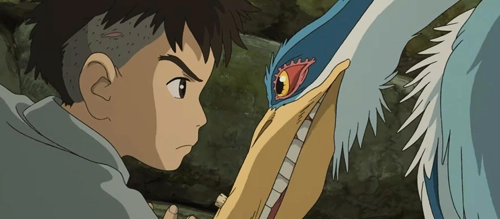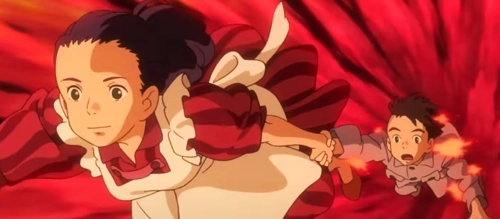The Boy and the Heron (2023) Review

The Boy and the Heron (2023)
Director: Hayao Miyazaki
Screenwriter: Hayao Miyazaki
Starring: Soma Santoki, Masaki Suda, Aimyon, Yoshino Kimura, Takuya Kimura, Shōhei Hino, Ko Shibasaki, Kaoru Kobayashi, Jun Kunimura
In 2013, Hayao Miyazaki released The Wind Rises, widely reported to be his final film before retirement. A year later, When Marnie Was There came out along with the rumour that it might be the last major work from hand-drawn animation dream factory Studio Ghibli. Happily, both Miyazaki and Ghibli’s animators continued to work tirelessly in relative secrecy until now, with The Boy and the Heron, and it’s up there with the best the studio has ever made.
This was a film very intentionally released without extensive promotion or fanfare, relying instead on Ghibli obsessives to create their own hype from a single poster and Miyazaki’s status as an animation god. The story centres on young Mahito (Soma Santoki) who escapes from war-torn Tokyo to his new stepmother Natsuko’s (Yoshino Kimura) countryside estate alongside his factory owner father (Takuya Kimura). While there, he is pursued by a strangely behaving, talking grey heron (Masaki Suda) before being mysteriously transported to another plane of existence.
For all the heart, the spirit, and the magic that Miyazaki brings to every one of his films he writes, directs and still has a personal hand in drawing, you have to acknowledge how deeply weird some of his ideas are. Like Grave of the Fireflies, the other prominent WWII-set Ghibli film by Miyazaki’s late friend Isao Takahata, this is about a child going through some things no one should have to experience so young. Perhaps inevitably he finds an escape in another world which might all be in his head, but there are plenty of more esoteric and surreal flights of fancy on offer as well. The heron with teeth, the chorus of chanting carp, and vertically-swarming frogs, are only the start of the madness to come.
The second half of The Boy and the Heron particularly has the feeling of a children’s story being embellished to keep a young audience’s attention from wandering, with bizarro imagination frequently threatening to derail sense in usually delightful ways. Just highlighting the key plot points is a somewhat surreal experience when they include following Mahito’s pregnant stepmother into another world via the floor of an ancient library; a magic fisherwoman teaching him how to nourish spirits so they can become souls in the land of the living; the latest descendant of a wizard’s bloodline needing to hold reality together using a child’s building blocks; and all that comes before the fascist parrots show up.
Where is this other world Mahito travels to? It seems to exist outside of life and death, beyond time itself, and is inhabited by people at different points of their personal timelines. It is perhaps deliberately open for debate and interpretation, but by the film’s close you’re inclined to think it was simply where the boy needed to be in order to make sense of being uprooted and heartbroken.

The hand-drawn animation is as pristine and detailed as you’d expect from Studio Ghibli in its realisation of impossible locations and fantastical creatures in contrast to the mundane, lived-in real world, but with more expressionist flourishes than usual reserved for Mahito’s hellish escape from a Tokyo ablaze, fire and figures warping and blending together in terrifying fashion. This perhaps has the most nightmarish and visceral imagery of any of the more fantastical Ghibli stories which might put off parents from showing younger children, with regular reminders of the pain and trauma (not least the untimely loss of his mother) that Mahito is trying to process.
We see birds of all kinds as something otherworldly here, as they often are in a wide range of cultures’ folklore. They are totems, omens. representations of life, death and rebirth. They are also generally not to be trusted, whether a scheming, diminutive man who appears to be 80% nose disguised as the titular heron, pelicans compelled to attack the soon-to-be-souls of the living, or an army of parakeets with designs on world domination, these feathered ones are certainly not our friends.
As well as his trademark dark and mature themes, you always find creatures simultaneously cute and grotesque populating Miyazaki’s worlds. Like the soot sprites of Spirited Away and the forest spirits of Princess Mononoke, this film’s blobby, floating, protein-hungry souls the Warawara hit instant iconic status. Being a Miyazaki film, we also of course have a couple of fire-throwing kick-ass heroines on hand to help our young protagonist on his journey, and a child-like sense of wonder about everything from the beautiful to the grotesque.
This film isn’t in any hurry to explain what it’s really about or to give Mahito a final destination, but that’s common with Miyazaki’s work operating on a fundamentally nonsensical dream logic much like the stories of one of his key influences, Lewis Carroll. Like Spirited Away, this has a lot of “Alice in Wonderland” about it and more than a little of L Frank Baum’s “Oz” stories too. The more existential threats and the film’s main antagonist don’t arrive until relatively late in the day for a mad rush to the finish, but this isn’t necessarily bad storytelling, just a style that gives more weight towards emotion and theme.
With The Boy and the Heron, Hayao Miyazaki has delayed his well-deserved retirement once again to produce another near-masterpiece. This dreamy, surreal and circuitous fable makes you feel, makes you think and makes you wonder if the master will manage another such animated wonder in the time he has left. Even if he doesn’t, this makes for a glorious final bow.
Score: 23/24

